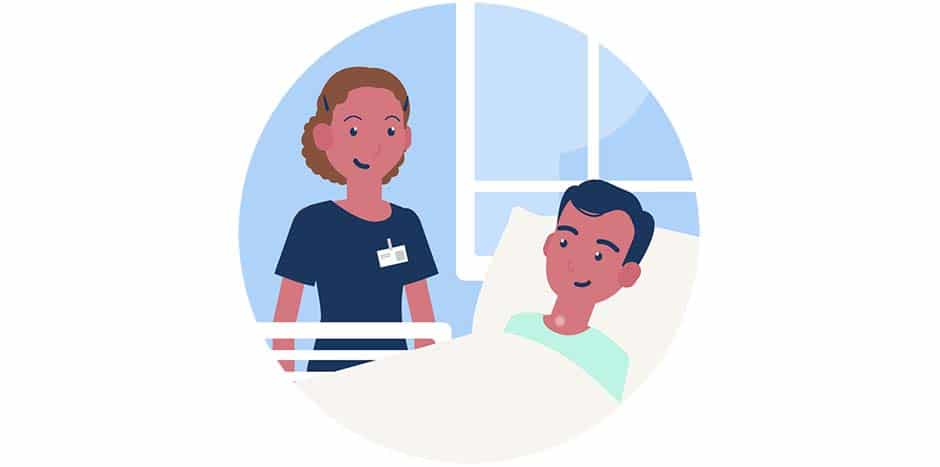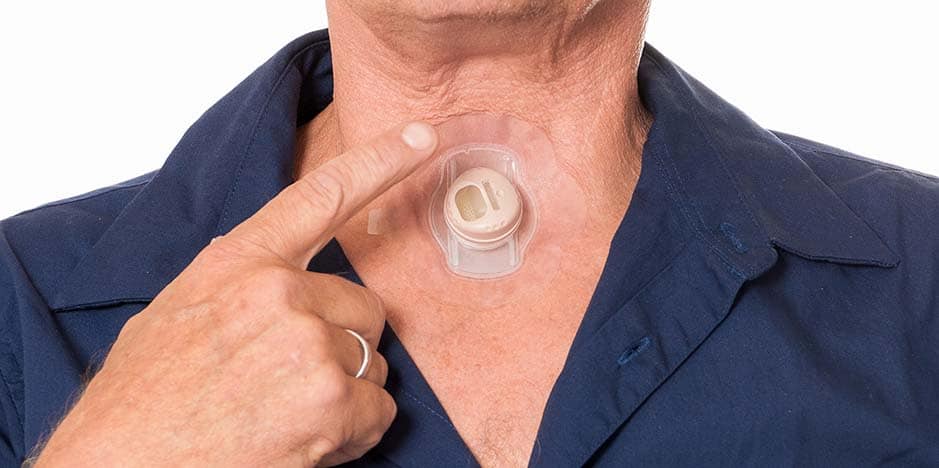Articles & Blog posts
Easy access
Make sure you can always access your favourite content by connecting My Content to your email.
Connect my emailAlready connected?
If you have already connected My Content to your email all you need to do is verify your email.
Verify my email10 May 2024
How to communicate after a total laryngectomy

We produce our voice through vibration. As air is passed through the vocal cords, they vibrate and produce sound. As the air then continues up your airways, it shapes that sound into speech.
So, after a total laryngectomy you will no longer have vocal cords and therefore will be unable to produce a voice through vibration as you did before. Your vocal cords are removed as they form part of your larynx.
But there are ways to produce a vibration that will help you produce a voice.
Ways to communicate after a total laryngectomy
After your total laryngectomy surgery, you will need to learn a new way of speaking. All these alternatives below, use another source to produce vibration other than your larynx to create your voice.
Today there are three alternatives to speak and communicate after a total laryngectomy:
- Using tracheoesophageal (TE) speech with a voice prosthesis
- Speaking with an electrolarynx (EL)/artificial larynx
- Using esophageal speech
After your total laryngectomy, your larynx is removed entirely. All the three alternatives mentioned above use another source than your larynx to create a sound. The source can be placed outside your body, like when using an electric device, or inside your body using structures in your throat.
When you have your meetings with your clinical team prior to the surgery, go through the options. Your medical team will share with you the option that will work for you after your total laryngectomy. However, the best option for you can only be determined after you have had your surgery.
Tracheoesophageal speech
With this alternative, your surgeon will make a hole, a puncture, between your windpipe and food pipe. This can also be done after your surgery and when you have healed.
In this hole, made by the surgeon, he or she will place a tube or a protheses. This will allow you to speak when it is open, and to drink and swallow food when closed.
Depending on how the surgery is being done, your speech language pathologist can replace your tube with a prothesis after your wound has been healed.
When breathing in and then covering your stoma, air from your lungs will be pressed through your prothesis. The vibrations created during this process will make the sound – you speak.
This is the most common and advanced method of communication. It is the most natural sounding voice in comparison to the other methods. Your surgeon will create a tracheoesophageal puncture (TEP) between your trachea/windpipe and your oesophagus/food tube and place a small silicone device called a voice prosthesis. This can be done at the time you have your total laryngectomy or later once you are healed.
The voice prosthesis does not make the sound but allows air to travel from your lungs into your oesophagus/food tube to produce sound. When you cover your stoma to speak, the air goes from your lungs through the voice prosthesis into your oesophagus/food tube. The oesophagus/food tube then vibrates and produces sound. That sound then travels to the mouth to shape it into speech. Learning to use your voice prosthesis is quite quick and easy and you may be able to communicate well the first time you try with very little effort.
Speaking with an electrolarynx
An electrolarynx, sometimes called an artificial larynx, is an electronic device that produces sound that can be shaped into speech. The electrolarynx produces vibrations to create sound which travels into your mouth either by placing the device up to your neck or cheek or by putting a small straw into your mouth. Once the sound is in your mouth, you then move your lips, teeth and tongue to shape that sound into speech to communicate. Many people can start using an electrolarynx right after surgery. Some use this as their main way of communicating and others use it as a back-up device or to be heard in a noisy environment. It is quite easy to learn and use.
Your voice with an electrolarynx will not sound like your old voice. Your voice will appear to sound electronic. Practice and your voice will become better and better.
Using esophageal speech
If you are using esophageal speech, you will make sound by pressing air into your food pipe/ esophagus. When air is going back up again from your lungs, there will be noise and speech when you shape your mouth.
Oesophageal speech uses the upper part of your esophagus/food pipe to produce sound.
The way it works is that you push the air that is in your mouth into your oesophagus/food pipe with your lips and tongue. Your esophagus/food pipe then vibrates producing sound. The sound then travels into your mouth and you move your lips, teeth, and tongue to shape that sound into speech. The number of words you can produce at a time is limited as you only have a small amount of air in your mouth. This method requires a lot of practice and over time becomes easier.



